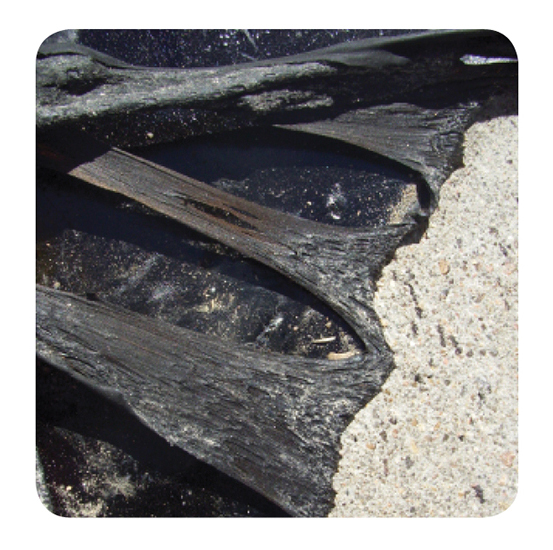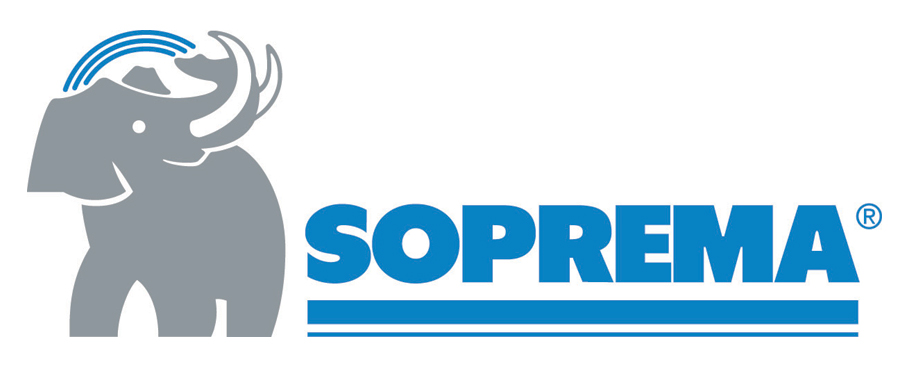Below-Grade Waterproofing Systems and Design
Substrate Preparation & Damage
Substrate preparation, in general, is key to the success of any waterproofing system. If the substrate isn’t adequately prepared, the correct application of the waterproofing system is next to impossible. In the picture below, the substrate was inadequately prepared, and the hot fluid applied system exhibited an adhesive bond failure.
Beyond preparation, issues with the substrate itself (such as cracked masonry) can lead to failure. You might wonder why anyone would attempt to apply waterproofing materials to a failing substrate, but unfortunately it does happen. In these cases, team members should always be notified of unsatisfactory substrate conditions.

Improper substrate preparation can lead to loss of adhesion during assembly.
Incompatible Materials
On any given below-grade waterproofing project, there will be various materials that will come into contact with each other. Assuring that these materials are “compatible” is essential to the success of the overall waterproofing. Be careful because the term “compatible” may have different definitions depending on whom you ask … answers of “Sure?,” “It will stick; don’t worry,” and “I don’t know,” are far too common. It is safe to assume that it is nearly impossible to make a statement about the compatibility of materials without first determining the function of the interactions between these materials.
Material Storage & Installation Conditions
As covered previously, there are various materials available for waterproofing applications. Each of these materials will have different restrictions and guidelines related to storage and application conditions. For example, a modified bitumen-based sheet will be less affected by low temperature conditions when compared to a water-based spray-applied product.
It is not uncommon to see materials become negatively affected when left improperly exposed. Whether or not a material can be brought back to a functional state after an event like this all depends on the material being used—you should always rely on the manufacturer’s requirements and recommendations. As a rule, if a pail of viscous material has polymerized or reacted, do not plan on using it. Polymerization is a chemical reaction in which two or more small molecules combine to form larger molecules that contain repeating structural units of the original molecules, and once this level of change has taken place, it is unlikely your material will be usable.
Keys to Success
As you have likely noticed, many of the leading causes of waterproofing failure are related to mistakes during installation, so Rule #1 for a successful installation is to follow best practices/directions precisely. Beyond this, also abide by the rules of good project design.
Good Initial Design
A good initial design begins with good communication between all team members. All involved team members need to be on the same page before and during the project to ensure a successful outcome. Waterproofing needs to be considered at the front-end of any building construction project—in the design phase of a project. Designers and architects should consult with waterproofing manufacturers and contractors during the design phase to ensure that all requirements are fulfilled. Many major problems with projects can be traced back to parties failing to talk with one another or pre-construction meetings not being scheduled properly, so take special care to avoid potential oversights early on.
When selecting a system design and what materials you will use for the project, there are a number of questions worth asking yourself in order to make an informed decision. Consider, for instance:
- What sort of site conditions exist? If a building site is right up against a property line, or there is no way to carry out positive-side waterproofing due to existing structures or other obstacles, you may know right away that a blindside waterproofing installation is your best bet.
- What are the soil conditions? At the start of a below-grade waterproofing project, a soil analysis needs to be conducted to help determine what type of waterproofing material will perform best in the given environment. Contaminated soil conditions may also limit your options. For example, contaminated ground water can turn sodium bentonite into less desirable calcium bentonite, effectively changing the properties of that waterproofing option. Sodium bentonite swells about 16 times its original volume whereas calcium bentonite will swell only about 5 times its original volume. Since the functionality of bentonite waterproofing is based on its ability to swell and seal, this makes a significant performance difference.
- What temperature limitations exist? Many waterproofing products—especially those requiring sealants, solvents or adhesives—become difficult to install in cold temperatures (below 40 degrees Fahrenheit or 4 degrees Celsius), meaning your material choice may be limited by your environment. Consult manufacturer-provided directions to know what sort of installation and storage limits exist.
- What is the hydrostatic pressure at the location? Different products have different tensile strengths, and the amount of pressure that must be withstood could affect your design. For instance, bentonite products and elastomeric sheets are more likely to withstand high hydrostatic pressure than fluid-applied systems or self- adhered membranes.
- What sort of drainage is there? Different waterproofing materials and applications lend themselves to different drainage designs, but regardless of the choices you make, some sort of drainage will need to be developed adjacent to membranes to efficiently remove water from surfaces.
- What will construction sequencing look like? Consider factors such as work benching (as you will need durable materials that can hold up to the abuse of consecutive trades), clear detail sequencing (to allow for a proper installation by contractors) and scheduling (as some products may not be able to cope with unforeseen project delays or weather conditions during certain times of the year).
- Are all applicable materials compatible? As discussed earlier, there are a lot of ways to describe compatibility, yet if several different types of waterproofing are to interact, compatibility at tie-ins and other intersecting locations must be properly defined and confirmed. If literature is not immediately available or you find yourself questioning compatibility, your best bet is to contact material manufacturers and ask.
- What are the code requirements? Local organizations approve certain products for certain types of projects. Codes that require a waterproofing membrane usually define the minimum required waterproofing system and give guidance around options for bridging nonstructural cracks. As a result, it is important to understand the code requirements for the project’s geographic location to ensure that the product specified meets all requirements.
- How much do you expect the building to move? Over time, and even by design, every building moves. This movement must be accounted for in the design phase, and waterproofing materials need to be selected to accommodate this movement through both material properties and adequate details. It is hard to predict where cracks will develop due to shifting structures, but pay special attention to any existing penetrations and construction joints when detailing, as these are the areas most likely to develop leaks when movement does occur.
- What will be the primary function of the building? The intended use of a building needs to be considered when choosing waterproofing systems. The approach may differ when waterproofing a museum versus a parking garage, for example. You should consider level of disruption installations could cause, the sensitivity of the contents of the building being waterproofed and how difficult repairs could be down the line depending on the type of system you select.
Strong Manufacturer Support
While there are often several factors that may cause a deviation from the original material selection for a project, and these factors are sometimes out of your control, you should never compromise on the right material for the job. Even after the design team identifies the right material for the project, economic reasons and warranty wars can alter that material selection—all performance characteristics aside.
It is not uncommon for a manufacturer to attempt to substitute their products on a project using the warranty as leverage, for instance, consider what happens to the warranty if that manufacturer goes bankrupt. Keep in mind that a proven track record is important. Companies often emerge touting the next revolutionary product that will never fail, but there is no substitute for a proven track record of success. Do your research not only on products, but also the companies offering them before making any choices for the best chance at success. Keep in mind that proper design inspection is crucial to system success, regardless of warranties.
Also, always assure both the installation and storage instructions are clear and appropriate to the project. It happens all too often that conflicting information can be found from a manufacturer, and this can jeopardize a successful installation.
Quality of Workmanship
It is always recommended that designers work with qualified professional waterproofing contractors, starting in the design phase. Installers on waterproofing projects should be manufacturer-approved, meaning they went through the manufacturer’s application and product-specific training program, and they understand how and when to use specific waterproofing materials.
It is also crucial to assure the people that were trained within the contractor crew are actually the ones doing the work. This can be verified by training certificates or applicator cards issued by the manufacturer. Be sure that if there are multiple crews, they are communicating with one another and that there is awareness regarding what others are doing to elicit the best outcomes.
Summary
Remember that protecting a structure from the elements is about more than just which roof to choose—integral and continuous building protection should be implemented from top to bottom. Although the cost associated with the below-grade waterproofing may not seem like a significant expenditure in the overall scope of a new construction project, it is not an area that should be overlooked, as it plays a vital role in building envelope protection. Do your due diligence up front, be sure you are familiar with the particulars of the materials you will be using and think carefully through the proper design for the project, and you will be well on your way toward avoiding installation problems, waterproofing failures and (possibly very expensive) reworks later on.
Thomas G. Bauer is the Product Manager—Waterproofing & Wall Systems for SOPREMA, and focuses his time and effort on perfecting the performance of wall systems and foundations to manage air, water and moisture movement. He has 12 years of experience within the waterproofing bitumen industry and more than eight years of product management experience. Prior to working in the waterproofing industry, Thomas spent eight years in environmental manufacturing development.

|
SOPREMA offers a comprehensive line of roofing, waterproofing, wall protection and civil engineering solutions combining superior products and systems with decades of proven performance. Our solutions include industry leading SBS-modified bitumen membranes, polymeric PMMA/PMA liquid applied membranes and synthetic single ply PVC membranes. www.soprema.us |









